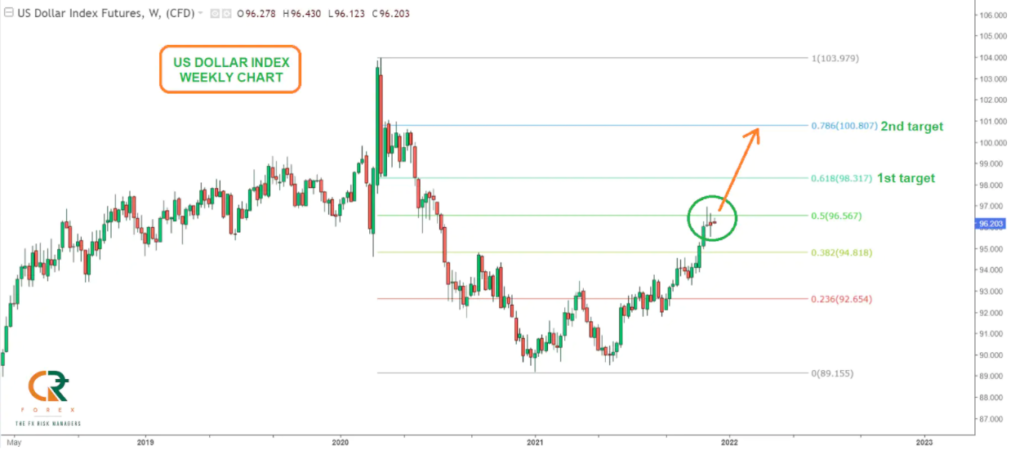- December 10, 2021
- Posted by: Amit Pabari
- Category: Uncategorized

Over the last few years, there were particularly two setups for the US dollar which were explaining the momentum. One is the ‘Risk-on’, led by higher growth in the US, monetary policy tightening, and inflation above the central bank’s target levels.
And another one is ‘Risk-off’ sentiment, in which the dollar strengthens due to a rush towards buying the safe-haven currency and selling a riskier one. That apart, there is one more concept which has come into the limelight over recent time is ‘Carry trade’ set up and unwinding of the carry. So basically, one can say that momentum in the US dollar is explained by three key sentiments. First: ‘Risk on’, Second: ‘Risk-off’, and third: ‘Carry trade position’.
Now let’s check which sentiment will drive the US dollar index towards 98.30 level over short term and 100 level over the medium term.
1. Risk-on (70 percent):
The higher risk-on on a comparable basis gives dollar an edge over other currencies. When central bankers across the globe are on an easing stance and flooding the higher liquidity- the US dollar trades on a sideways to bearish as riskier assets and currencies grab more investments attention.
At that time due to lower rates in the United States, the US dollar index remains well ignored. But only when growth picks up in the US and has relatively stronger fundamentals then peers, then the US dollar index comes into the picture and dominates over the riskier one. That is what happening currently.
Up to May month, US dollar index was under pressure as easing was seen across all major countries. However, on account of rising US inflation and stronger economic data, US central bank tone was seen turning hawkish. One can say it was more risk-on for the US and less risk-on for the other countries. Here, we need to check on a comparative basis also.
Despite the ongoing sharp jump in cases across the US, Europe, UK, and other developed markets, the US dollar index is still quoting on a stronger foot. Over the past 1.5 months, one can observe that most parts of Europe and up to some extent the UK too grappled with rising COVID cases despite higher vaccination drive. At the same time, the US is still well behind on the curve. That is giving US a comparative advantage over peers. Further, Fed and U.S. administrations are not much showing concern over the new variant Omicron yet.
The data has been better than expected for the US dollar index to remain solid. The recently released job report suggests that the US unemployment rate is falling to 4.2 percent, at a pre-pandemic level. Inflation has been running hot at 6.2 percent, the highest since November 1990. As crude oil prices have corrected by almost 23 percent in just a month, the inflation could come near the previous figure or slightly below the previous month’s figure.
Given above factors are enough to pressurize on fed to accelerate the pace of tapering at the December meeting. That apart, a fresh ‘dot plot’ of an FOMC member’s probability of rate hike and quarterly projections will gain attention. If fed jumps higher on the ladder of tapering, then DXY could jump to 97.80 to 98.30 levels. At last, one can say that 70 percent of the movement in the US dollar index will be justified by the risk-on sentiment over the short and medium term.
2. Risk-off sentiment (20 percent):
It is obvious that when risk is perceived to be high, traders will shift towards lower-risk investments. Investors keep on jumping on the different asset classes depending on the ongoing riskiness in the market. For instance, the equity market is generally considered to be riskier than fixed income (name only suggests its feature) like T-notes or bonds.
An example of risk-off sentiment could be the 1997 Asian Financial Crisis, 2008 Global Financial Crisis, or the 2020 COVID pandemic when equities had suffered a sharp fall. And that apart, any geopolitical tension, border war, trade war, natural calamities, or downgrade of country’s debt have a larger impact on the riskier assets. And hence, risk-off trades gain traction.
A sudden rush to sell riskier assets and currencies helps US dollars to remain on the bid side of safe-haven. Till the time, the central bank comes up with loosening of their monetary policy, the US dollar remains on a strong foot. After last year’s pandemic, now the world is habitual of new variants- Be it Delta or Omicron or any upcoming variant. Yes, that impacts the economic outlook and business activity. But central bankers are very quick to act upon it.
We believe that 20 percent of the US dollar movement is justified by some risk-off sentiment. And hence, this point also suggests a stronger dollar.
3. Carry trade (10 percent):
Apart from actual demand for the US dollar for trade purposes, in the modern world investors have started betting on it. They take the advantage of the interest rate differential based on growth, inflation, and return outlook. Further, the trade set up for carry and unwinding of carry has a large impact when something happens all of a sudden.
For a Carry trade set up, global traders borrow in a zero or lesser yielding currency like Yen or Euro (called funding currency) and invest in a higher-yielding currency like the US dollar and Rupee. At the time of borrowing, traders go short on it (Yen and Euro) and at the time of investment, traders go long on those currencies (dollar and rupee). Throughout 2021, traders were continuously going short on Euro and long on dollar.
When these carry trades start unwinding due to any uncertain event, like what happened over the last week of Nov 2021 when Omicron was announced, the trader starts squaring off position by taking the opposite position. And hence, Euro and Yen strengthened and the US dollar along with EM currencies (including the Rupee) sold off. However, that was very short lived say for a week only.
Post that, US dollar index was seen recovering again and Euro started falling again. We believe that this carry trade likely to justify 10 percent of the movement in the US dollar. In the current scenario where Fed is hawkish, we are expecting that the US dollar carry trade setup is expected to continue in 2022 also and so a bullish dollar index story of 100 level.
Technical Development:
After bottoming out near the 89.20-50 zone twice a time, the US Dollar index was seen riding on a bullish note towards the 97 mark. However, there comes a minor hurdle of 50 percent retracement. The recent indecisive move over the last two weeks suggests some consolidation before another breakout towards 61.8 percent retracement of 98.30 levels and 78.6 percent retracement of 100.80 levels.
After consolidating for a week or two, we can expect another impulsive wave unfolding on the higher side. On the flip side, immediate support for the index lies at 95.50 and then at 94.60-80 zone. But this seems unlikely to break over the short and medium-term.

Outlook:
Spot US Dollar index: (Spot level- 96.20)
Overall, odds are in favor of a stronger US dollar as risk-on sentiment in the US on an absolute basis, higher expectation of further acceleration in tapering and hawkish dot plot in the December meeting could keep on favoring dollar bulls. At the same time, crude oil prices seems coming under control and could calm down the skidding inflation expectation.
If the odds go against, that means if risk-off sentiment drives the momentum then also dollar index could move higher due to the rush towards coverage of dollar. And, another financial market variant- Carry trade set up is also suggesting dollar will into a demand zone. Summing up in short, we are expecting the US dollar index to move higher towards 98.30 in the near term with a 1-3 months perspective and then above 100 mark over the medium term with 3-6 months perspective.
Outlook on Euro: (Spot rate- 1.1300)
A stronger dollar could keep pressurizing on its peer currency. And hence, the Euro-dollar pair could fall towards 1.10 over the short term and 1.07 over the medium term. In rupee terms, the Euro-rupee pair is expected to remain under pressure with potential downside up to 83 and 81.50 levels.
Outlook on Pound: (Spot rate- 1.3300)
In the same way, we can expect the Pound to remain under pressure and drift further lower towards 1.3000 over the short term and 1.2800 over the medium term. In rupee terms, the British pound sterling- rupee pair is expected fall further towards 98.50 and 97 levels.
—Amit Pabari is the managing director of CR Forex Advisors. Views expressed are personal.




